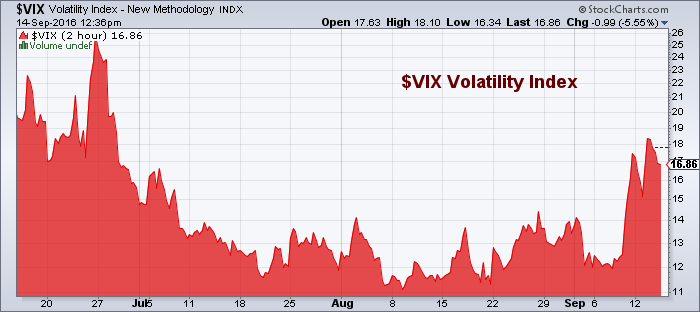Welcome back, volatility. The VIX Volatility Index (INDEXCBOE:VIX) jumped again yesterday as investors were whipped around for another day. Following 43 days spent within a narrow trading band (a total range of 1.75%), the S&P 500 Index (INDEXSP:.INX) has now had three consecutive days with moves in excess of 1.5%.
With yesterday’s trading staying within the range marked out on Monday, it looks like 2120 is an important support level for stocks. A failure to hold 2120 could lead to an eventual test of the 200-day average (near 2060). On the upside, meaningful price resistance resides near 2160.
We were encouraged that the stock market held support yesterday. As well, the surge in the TRIN (a measure of short-term buy/selling pressure) for the NYSE, moved well above 2. This indicates some excessive selling pressure. On the other hand, the TRIN for the NASDAQ remained low all day and its sub-1 reading is actually more consistent with relative buying pressure than selling pressure. Yesterday also brought another trading session (the second in three days) during which down volume on the NYSE outpaced up volume by a ratio of more than 10-to 1. This is evidence that downside momentum is building in the stock market.

After a 20% rally on the S&P 500 from mid-February to mid-August, some pullback/correction going into a tumultuous presidential election should not surprising. As long as longer-term breadth trends remain robust, any correction is expected to be limited in degree and duration. Our industry group trend indicator rose from 12% to 84% over the course of the rally, but has now dropped back to the low 70s and could see further weakness. Evidence that fewer than half of the groups remain in up-trends could raise the risk of a more substantial correction.
Bond yields rose again today, with the benchmark 10-year T-Note yield breaking out to the upside and reaching its highest level since late June. While last week’s uptick in yields seemed to be spurred by Central Bank related news and commentary, the rise in yields today came as a response to genuinely good news for the economy. The Census Bureau reported that real household median incomes rose more than 5% in 2015, the first increase since 2007. This news also helped the dollar rally. Dollar strength and higher bond yields combined to weigh on both dollar-sensitive (like commodities and emerging markets) and rate-sensitive (high-dividend plays) areas of the stock market.
To gain confidence that a near-term low is in place, we will be watching our short-term breadth measures (particularly our sector-level trend indicator) for evidence that downside momentum is fading. After seeing evidence of excessive optimism coming into September, we now need evidence of excessive pessimism to suggest the sentiment has turned more favorable. Specifically, we are looking for a sharp reduction in equity exposure as measured by the NAAIM and a likely surge in the VIX into the mid- to upper 20s (currently 18.5).
Bottom Line: Holding support as selling pressure has expanded is encouraging, but second-half of September is notoriously weak and we need better evidence of broad market stability.
Thanks for reading.
Twitter: @WillieDelwiche
Any opinions expressed herein are solely those of the author, and do not in any way represent the views or opinions of any other person or entity.








